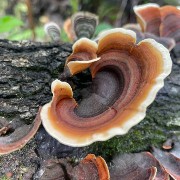Mush Ado About Nothing?
The promise of summer brings so many new curiosities to our landscapes. One of the most dramatic and surprising of these changes is the arrival of mushrooms in our environments. Seemingly appearing between the afternoon rainfall and the following morning, fungi are at work beneath our feet and mushrooms are the continuation of their story…
Fungi are neither plants nor animals but exhibit some similarities to both. Fungi can be microscopic and single-celled or, like the honey mushrooms in Oregon, grow to cover thousands of square kilometers and weigh as much as 200 gray whales. Despite their great diversity, he fungal kingdom is the least studied of the five kingdoms.

Florida is home to many beautiful and interesting fungal species. While the variety and growth habits of fungi change across habitat types, they all share some common characteristics. Fungi have specialized structures called mycelium that act as anchors, food gathering, invading army, and nurturing plant protector (sometimes all at once). The mycelium is a thread-like structure that creates a ‘web’ within the soil, decaying wood, or other decomposing material. As the mycelium breaks down these materials, it provides a necessary service to the surrounding ecosystem. The nutrients become available for other organisms. Some plants rely entirely on mycelium to provide necessary nutrients. Plants and fungi often exist in a relationship of mutual benefit, where mycelium acts as the undertakers, merchants and orators of the subsoil. Taking nutrients from dead organisms trading nutrients and water with plant roots and helping form a communication network is known as the wood wide web.

When environmental conditions are right for fungal reproduction (often after a soaking rainfall) the hyphae (specialized tips of mycelium) will gather to create fantastical reproductive structures known as mushrooms. Mushrooms are the most recognizable part of a fungus and have had a distinct presence in art, literature, and popular culture for thousands of years. The mushroom contains the reproductive spores of the fungus, which are spread via wind, water or animal to a new location.
Can I Eat It?
Many animals consume mushrooms, including humans! Most familiar are the common button or portobellos that are sold in most grocery stores, but edible mushrooms come in many shapes and colors. While some mushrooms that grow in Florida are edible, it is important that you never ever (and I mean NEVER) eat a wild foraged mushroom without expert identification. Many edible mushrooms have poisonous doppelgangers or have absorbed pollutants from the surrounding environment.
Mushrooms are an excellent source of essential vitamins and minerals. Many species contain, probiotics, prebiotics and immune supporting compounds as well. Research continues into the use of some mushroom compounds as treatments for cancer, depression, auto immune and neuro-degenerative diseases.
Check out this infographic to learn the basic parts and functions of a mushroom:
More Info:
If you have a mushroom you need identified follow this link.
If you are interested in learning more about mushrooms, check out this article.
If you want to learn how to grow oyster mushrooms at home, read this.
Extension Agents from across the Southwest District are working to bring you more mushroom programs. Keep your eyes and ears open for more mushroom news as we schedule webinars, in-person classes and mushroom identification hikes for fall 2021.
This blog was written collaboratively by: Alyssa Vinson, David Outerbridge and Armando Ubeda
 1
1

